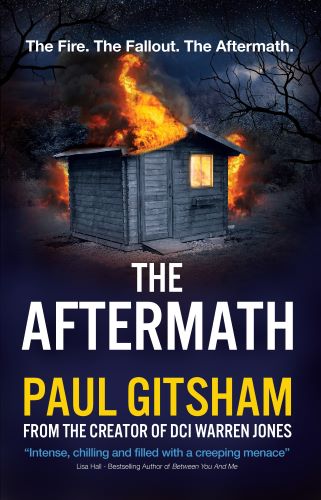I Spy With My Little Eye…
Using CCTV in your novel (Part 2)
This is the second in a three-part post looking at video surveillance and how it could be used in your books. Last week’s post introduced some examples of CCTV and also dispelled some common myths. Today I will focus on complementary technologies such as night vision and ANPR. Pop back next week for a discussion about some more recent innovations that may give inspiration for your work.Night Vision
In recent years, the ability to see in the dark has moved from specialist, often military, applications to the mainstream. Peruse a catalogue of residential security systems and cameras with low-light or night vision are now the norm, even at the cheaper end of the market.
So I thought it may be useful to explain what this is and how it works. But first of all, I need to clear up a misconception.
Night Vision is NOT the same as Thermal Imaging.
I am sure everybody is familiar with footage from TV of police helicopters chasing joyriders in the pitch black, late at night. The miscreants typically end up crashing or abandoning their vehicle, before leaving on foot and trying to hide in somebody’s back garden.
They can easily be seen as glowing heat spots against a cooler background. The police and dog teams chasing them are similarly visible. From above, the helicopter crew direct their colleagues on the ground towards their quarry.
Thermal Imaging (or ‘Heat Vision’), works because all objects emit infra-red radiation. The intensity of this radiation, which is invisible to human eyes, varies depending on the temperature of the object. Human beings are typically warmer than their surrounding environment, and so they standout against the background. Heat-sensitive cameras can detect this invisible radiation, and will produce an artificially-coloured image that can be seen by the operator. The infra-red radiation can be blocked by buildings etc, but hiding under a tree or in a bush won’t work.
This technology is also used by the military.
Night Vision also relies on Infra-Red.
Night vision, or low-light enhanced images also require infra-red, but work a little differently. Human beings can see a fairly narrow range of colours (referred to as wave-lengths, or frequencies). What we perceive as white light, or natural light, is a mixture of these colours.
When we see an object, what we are actually seeing is the light reflected from a surface that enters our eyes. Light moves in a straight-line from a light source, and is then reflected or absorbed by an object, and it is these reflections that we see. The more light that our eyes receive, the better we are able to see. This is why we see more clearly when we turn up the brightness on a lamp, for example.
However, because we can only see a relatively narrow range of wavelengths, the light that is invisible to us, such as infra-red, goes unnoticed.
In low-light systems, the camera is able to pick up this extra infra-red and, after adjusting its colour to make it visible to human eyes, adds it to the image on the screen, so the picture is brighter with more detail. Your mobile phone camera uses this trick to make pictures taken in dim light brighter.
This system is called ‘passive infra-red‘. It is simply collecting and using more of the light already available.
Active infra-red uses the same principle as turning on a torch or a light to see in the dark. If I want to ensure that a security camera outside my house gets a clear image of somebody entering my back garden in the dead of night, then the obvious thing to do is flood my backyard with a high-powered light. That light will be reflected off any objects it hits and return to the camera, in exactly the same way that natural sunlight is reflected during the day.
For obvious reasons, this is not desirable.
Active infra-red systems work by shining invisible infra-red light, and then capturing the reflected infra-red light on a low-light camera. Because the infra-red light cannot be seen, the area remains pitch-black. As IR is not a colour that our eyes can perceive, the computer-generated images are grey-scale (black or white).
The quality of the images generated can be variable. A close-up image of a person’s face (such as a burglar!) can be good enough to allow them to be easily identified. Car license plates vary. Because the plates are coated in a reflective material, bright lights shining on them may make them unreadable, whilst paradoxically, those in shade may be more readable. I did a quick experiment and found that I was unable to read my own car’s licence plate which is directly under the camera, but could see my neighbour’s, which is parked at an angle to the camera.
How could you use this in your book? Could the police be chasing a suspect at night with the aid of a helicopter (thermal imaging)? How useful is the night vision on a security camera? Is it good enough to identify a suspect or will you decide that it won’t stand up in court?
Automatic Number Plate Recognition (ANPR).
The system works by automatically recording the licence plate of a vehicle, which a computer will then read and store or use immediately. As the computer systems get more sophisticated, the need for human assistance to read strangely formatted or dirty licence plates becomes less necessary.
Examples of the system’ use include:
Law enforcement. The police have access to large numbers of ‘traffic cameras’. These may be fixed surveillance cameras mounted on poles over roads or traffic lights, or mobile cameras attached to the dashboard of police vehicles.
Local Councils. They can be used to help enforce civil penalties, for example monitoring the use of residential parking permits.
Commercial operators. These might include councils, but would also include the owners of car parks – increasing numbers of car parks photograph the licence plate of cars entering and leaving and use this to calculate parking charges. Other uses of ANPR include filling-station forecourts, to deter and capture fuel thieves.
What happens next depends on the context in which it is used.
For the police, the system might be tied in directly to the Police National Computer and systems such as the Motor Insurance Database. Cars that are associated with persons of interests or active investigations may then be identified, as would cars being driven illegally without insurance etc, or stolen vehicles.
The camera network can also be used to track a vehicle’s journey – either retrospectively, to work out where a vehicle has been eg when trying to solve a case – or in real-time, if the police are trying to find an suspect in an ongoing situation.
For a car park, the system would usually be completely closed. The computer simply notes that a car entered, then notes the time that it left. If the police want access to that information, to either track down the whereabouts of a suspect or to determine if they were parked in that area at the time of an offence, they would have to ask the operators. Many car parks are operated by the same company, eg NCP, so a request for information can be applied to all of their properties.
For parking penalty enforcement, the operator would submit registrations for vehicles that they believe have infringed the rules to the DVLA (Driving and Vehicle Licencing Agency), who would then give them the details of the registered keeper which the operator will then chase down.
That’s it for this week. Next week, I will conclude this mini-series with a look at the future and some other uses of video surveillance technology, such as body-worn cameras, dashcams and even Google Street View!
As always, feel free to comment here or on social media.
All the best,
Paul




















